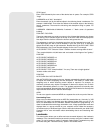
31
Before trying out the examples in this section, familiarize yourself with the basic
operations of Autostar described earlier in this manual. The following examples
assume that you have a basic knowledge of Autostar and understand how to scroll to
a desired menu or menu option and how to enter numbers and text. It also assumes
that you have initialized Autostar and have placed the telescope in the "Home"
position (when appropriate).
Adding Observing Sites
If you plan to observe using Autostar at different geographic locations, you can store
up to six observation sites in Autostar's memory to help simplify your telescope setup.
Perform these procedures using the Site options (Add, Select, Delete, Edit) of the
Setup menu.
To Add a Site to the user-defined site list:
In this example, you will choose a city and add it to the database list. You will then
select the site to enable it.
1. Navigate to the "Setup: Site" menu. Press ENTER,
2. Scroll through the options until "Site: Add" displays. Press ENTER.
3. Scroll through the list of countries/states. Press ENTER when the country/state
you wish to add displays.
4. Scroll through the list of cities. Press ENTER when the city you wish to add
displays. The Site is now added to the database. You may add 5 sites using this
method (the sixth site is the site you entered during the Initialization process)
5. To choose a site, navigate to "Site: Select." Press ENTER. Scroll through the list
of sites. When the desired site displays, press ENTER.
To Edit a Site:
In this procedure, you will enter a location that is not available in the Autostar data-
base by editing data of a nearby site. You will edit the location's name, latitude,
longitude and the time zone shift. You will then select the site to enable it.
You will need to know the latitude and longitude of your location to perform this
procedure. This information is available on most maps.
1. Using the Add option, choose a site on the list that is closest to your observing
site and press ENTER so that the site is added to your observing sites list.
Choosing a site already on the list (as opposed to using the "Custom" feature)
makes it easier to edit, as the "Time Zone" value may not need to be changed.
2. Scroll to "Site: Edit" and press ENTER. "Edit: Name" displays. Press ENTER.
3. The name of the site you have just entered to your list displays; if it does not,
scroll to the site.
4. Using the Arrow keys, change the name of the site so that it now reads the name
of your observing location. Press ENTER. "Edit: Name" displays again.
5. Press the Scroll Down key and "Edit: Latitude" displays. Press ENTER.
6. Using the Number Keys, enter the latitude of your observing site and then press
ENTER. "Edit: Latitude" displays again.
7. Press the Scroll Down key and "Edit: Longitude" displays. Press ENTER.
8. Using the Number Keys, enter the longitude of your observing site and then press
ENTER. "Edit: Longitude" displays again.
9. Press the Scroll Down key and "Edit: Time Zone" displays. Press ENTER. (If the
site you chose from the list in step 1 has the same Time Zone as the site you are
editing, just press ENTER again to go on to the next step.) "Time Zone" refers to
the Greenwich Time Zone shift. Users West of Greenwich, use "-" hours (one
hour per time zone) and users East of Greenwich use "+" hours. For the United
States, look up the shift in
Table 1, at the left.
10. After entering the shift, press ENTER. "Edit Time Zone" displays.
11. Press MODE. "Site: Edit" displays.
12. Using the Arrow keys, scroll to "Site: Select." The site you have just edited
displays. Press ENTER to select the site or press MODE to exit.
ADVANCED AUTOSTAR
OPERATION
Time Zone Shift
Atlantic -4 Hours
Eastern -5 Hours
Central -6 Hours
Mountain -7 Hours
Pacific -8 Hours
Alaska -9 Hours
Hawaii -10 Hours
Table 1: Time Zone Shift.
Calculations are for standard
time.


















